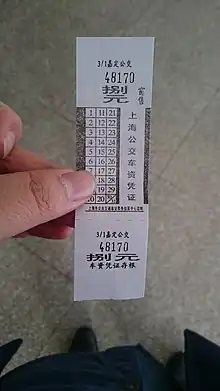捌
| ||||||||
Translingual
Han character
捌 (Kangxi radical 64, 手+7, 10 strokes, cangjie input 手口尸弓 (QRSN), four-corner 52000, composition ⿰扌别 or ⿰扌別)
References
- KangXi: page 433, character 18
- Dai Kanwa Jiten: character 12141
- Dae Jaweon: page 783, character 1
- Hanyu Da Zidian (first edition): volume 3, page 1883, character 5
- Unihan data for U+634C
Chinese
Glyph origin
Phono-semantic compound (形聲, OC *preːd, *praːd) : semantic 扌 (“hand”) + phonetic 別 (OC *pred, *bred).
Pronunciation
See also
| Chinese numbers | ||||||||||||||||
|---|---|---|---|---|---|---|---|---|---|---|---|---|---|---|---|---|
| 0 | 1 | 2 | 3 | 4 | 5 | 6 | 7 | 8 | 9 | 10 | 102 | 103 | 104 | 108 | 1012 | |
| Normal (小寫/小写) |
〇, 零 | 一 | 二 | 三 | 四 | 五 | 六 | 七 | 八 | 九 | 十 | 百 | 千 | 萬/万 十千 (Malaysia, Singapore) |
億/亿 | 兆 (Taiwan) 萬億/万亿 (Mainland China) |
| Financial (大寫/大写) |
零 | 壹 | 貳/贰 | 參/叁 | 肆 | 伍 | 陸/陆 | 柒 | 捌 | 玖 | 拾 | 佰 | 仟 | |||
Etymology 2
From Proto-Sino-Tibetan *brat (“cut apart, cut open”). Cognate to 別.
Pronunciation
Definitions
捌
Etymology 3
| trad. | 捌 | |
|---|---|---|
| simp. # | 捌 | |
| alternative forms | ||
Min dialectal word for "to know".
Austroasiatic substrate influence (Norman and Mei, 1976); may be related to 別 (“to split; to differentiate”). Cognate with Vietnamese biết (“to know”), Muong mắt (“to know”), Proto-Bahnaric *băt (“to remember, to know”), Proto-Hmong-Mien *pei (“to know”) (White Hmong paub (“to know, to understand”)).
Many variant written forms exist, but 捌 is recommended in the Taiwanese Southern Min Recommended Characters lists (《臺灣閩南語推薦用字》) published by Taiwan's Ministry of Education.
Pronunciation
Definitions
捌
- (Min) to know; to recognise; to be familiar with
- 捌字 [Min Dong] ― báik-cê / [pɛiʔ²⁴⁻⁵⁵ t͡sɛi²⁴²] [Bàng-uâ-cê / IPA] ― to know how to read
- 𣍐捌字/𫧃捌字 [Min Dong] ― mâ̤-báik-cê / [mɛ²⁴²⁻²¹ (p-)βɛiʔ²⁴⁻⁵⁵ t͡sɛi²⁴²] [Bàng-uâ-cê / IPA] ― do not know how to read
- (Min) to know (somebody)
- 伓捌 [Min Dong] ― n̂g-báik / [(ŋ̍-)m̩²⁴²⁻⁵³ (p-)maiʔ²⁴] [Bàng-uâ-cê / IPA] ― to not know (someone)
- (Hainanese) to know how to (do something)
- (Min Dong, Hokkien) already; previously
- 捌曾 [Min Dong] ― báik-cèng / [pɛiʔ²⁴⁻²¹ t͡sɛiŋ⁵³] [Bàng-uâ-cê / IPA] ― a term denoting past tense
- 捌做過/捌做过 [Hokkien] ― bat chò--kòe [Pe̍h-ōe-jī] ― to have done something already
Synonyms
| Variety | Location | Words |
|---|---|---|
| Formal (Written Standard Chinese) | 認識 | |
| Mandarin | Beijing | 認識 |
| Taiwan | 認識 | |
| Singapore | 認識 | |
| Cantonese | Guangzhou | 識得, 識 |
| Hong Kong | 識得, 識 | |
| Zhongshan (Shiqi) | 識 | |
| Yangjiang | 識得, 識 | |
| Kuala Lumpur (Guangfu) | 識 | |
| Singapore (Guangfu) | 識 | |
| Hakka | Meixian | 識, 識得 |
| Miaoli (N. Sixian) | 識 | |
| Pingtung (Neipu; S. Sixian) | 識 | |
| Hsinchu County (Zhudong; Hailu) | 識 | |
| Taichung (Dongshi; Dabu) | 識 | |
| Hsinchu County (Qionglin; Raoping) | 識 | |
| Yunlin (Lunbei; Zhao'an) | 識 | |
| Senai (Huiyang) | 識 | |
| Jin | Taiyuan | 認得 |
| Min Dong | Fuzhou | 捌, 捌傳 |
| Min Nan | Xiamen | 捌 |
| Quanzhou | 捌 | |
| Shishi | 捌 | |
| Zhangzhou | 捌 | |
| Taipei | 捌 | |
| New Taipei (Sanxia) | 捌 | |
| Kaohsiung | 捌 | |
| Yilan | 捌 | |
| Changhua (Lukang) | 捌 | |
| Taichung | 捌 | |
| Tainan | 捌 | |
| Hsinchu | 捌 | |
| Kinmen | 捌 | |
| Penghu (Magong) | 捌 | |
| Penang (Hokkien) | 捌 | |
| Singapore (Hokkien) | 捌 | |
| Manila (Hokkien) | 捌 | |
| Chaozhou | 捌 | |
| Shantou | 捌 | |
| Shantou (Chenghai) | 捌 | |
| Jieyang | 捌 | |
| Bangkok (Teochew) | 捌 | |
| Johor Bahru (Teochew) | 捌 | |
| Singapore (Teochew) | 捌 | |
| Leizhou | 捌 | |
| Wenchang | 捌 | |
| Haikou | 捌 | |
| Singapore (Hainanese) | 捌 | |
| Wu | Shanghai | 認得, 相熟 dated |
| Wuxi | 認識 | |
| Wenzhou | 識 | |
Japanese
Korean
Hanja
捌 • (pal) (hangeul 팔, revised pal, McCune–Reischauer p'al, Yale phal)
- This term needs a translation to English. Please help out and add a translation, then remove the text
{{rfdef}}.
